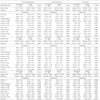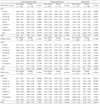Abstract
The purpose of this study was to evaluate nutrition intake and diet quality according to beverage consumption status in elementary school students (ESS = 317), middle-school students (MSS = 431), and high-school students (HSS = 373). We analyzed data from the combined 2007-2008 Korean National Health and Nutrition Examination Survey (KNHANES). Subjects were divided into two groups, the non-beverage group and the beverage intake group according to beverage intake from drink types (fruit-vegetable drinks, carbonated drinks, and dairy drinks). Intake of dairy drinks was significantly lower in the carbonated drinks intake (CDI) group, compared with the non-CDI group in the MSS group. Intake of vitamin C was significantly higher in the fruit-vegetable drinks intake (FVDI) group, compared with the non-FVDI group. Intake of Ca and P was significantly lower in the CDI group, compared with the non-CDI group. Intake of vitamin B2, Ca, and P was significantly higher in the dairy drinks intake (DDI) group, compared with the non-DDI group. The mean adequacy ratio (MAR) of the FVDI group and the DDI group was significantly higher than those of the non-FVDI and non-DDI group. In diet quality, nutrients less than 1 on the index of nutritional quality (INQ) were significantly higher in the CDI group, compared with the non-CDI group. In conclusion, consumption of carbonated drinks dropped the diet quality however, consumption of fruit-vegetable drinks and dairy drinks improved the diet quality of micronutrients. Therefore, a well-planned diet must be used for replacement of nutrients lost from excessive intake of carbonated beverages during a time in life when growth is especially prominent.
Figures and Tables
Table 1
General characteristics in elementary school, middle-school and high-school students

1) Mean ± Standard error 2) p < 0.05 Significance between elementary school student and middle-school students at α = 0.05 by Tukey tests 3) p < 0.05 Significance between elementary school student and high-school students at α = 0.05 by Tukey tests 4) p < 0.05 Significance between middle-school student and high-school students at α = 0.05 by Tukey tests
References
1. Gibson EL, Wardle J, Watts CJ. Fruit and vegetable consumption, nutritional knowledge and beliefs in mothers and children. Appetite. 1998; 31(2):205–228.

2. Jo JI, Kim HK. Food habits and eating snack behaviors of middle school students in Ulsan area. Korean J Nutr. 2008; 41(8):797–808.
3. Korea Centers for Disease Control and Prevention, Ministry of Health, Welfare and Family Affairs. 2009 National Health Statistics - The 4th Korea National Health and Nutrition Examination Survey, the third year (2009). 2010. Cheongwon: Korea Centers for Disease Control and Prevention;p. 286.
4. Lee EJ, Hwang IK, Jin BH, Paik DI. Correlation between snack food intakes and dental caries in elementary school children. Korean J Food Cookery Sci. 2008; 24(2):251–257.
5. Park EH, Bae YJ, Kim SK, Kim MH, Choi MK. A study on beverage consumption of elementary school students in Chungnam. Korean J Food Nutr. 2011; 24(3):376–385.

6. Kim JH. The improvement plan and status on children's favorite foods such as carbonated drinks etc. Food Ind Nutr. 2006; 11(2):55–58.
7. Chung SJ, Kim JH, Lee JS, Lee DH, Kim SH, Yu CH. A suggestion to develop a nutrition policy on food and nutrition labeling and education systems for fast food and carbonated soft drinks in Korea. Korean J Nutr. 2004; 37(5):394–405.
8. Ock SM, Kim CM, Ock CM, Choi WS. Bone acquisition related health behavior factors and nutritional uptake in high school girl student. J Korean Acad Fam Med. 2002; 23(7):905–916.
9. Choi MH, Kown KI, Kim JY, Lee JS, Kim JW, Park HK, Kim MC, Kim GH. Monitoring of total sugar contents in processed foods and noncommercial foodservice foods. Korean J Food Sci Technol. 2008; 40(3):337–342.
10. Kim JH. The improvement plan and status on children's favorite foods such as carbonated drinks etc. Food Ind Nutr. 2006; 11(2):55–58.
11. World Health Organization. Diet, nutrition, and the prevention of chronic diseases: report of a joint FAO/WHO Expert Consultation. WHO Technical Report Series 916. 2003. Geneva: World Health Organization.
12. Yoon MH, Lee MJ, Hwang SI, Moon SK, Kim JK, Jeong IH, Yim JR. An evaluation of caffeine contents in commercial foods. J Food Hyg Saf. 2001; 16(4):295–299.
13. Kim SD, Yun ES, Chang MS, Park YA, Jung SO, Kim DG, Kim YC, Chae YZ, Kim MY. Survey of daily caffeine intakes from children's beverage consumption and the effectiveness of nutrition education. J Korean Soc Food Sci Nutr. 2009; 38(6):709–720.

14. Kim BS, Lee KA. Comparisons of the daily activities and energy expenditures of normally-weighted and obese elementary school children. Korean J Nutr. 2005; 38(10):847–855.
15. Kim SY, Ryu SA. The relationship between beverage consumption, nutrient intake and body mass index in elementary school students in Gyeongnam area. Korean J Nutr. 2008; 41(6):530–538.
16. Wilson JF. Lunch eating behavior of preschool children. Effects of age, gender, and type of beverage served. Physiol Behav. 2000; 70(1-2):27–33.
17. Van Wymelbeke V, Béridot-Thérond ME, de La Guéronnière V, Fantino M. Influence of repeated consumption of beverages containing sucrose or intense sweeteners on food intake. Eur J Clin Nutr. 2004; 58(1):154–161.

18. Blum JW, Jacobsen DJ, Donnelly JE. Beverage consumption patterns in elementary school aged children across a two-year period. J Am Coll Nutr. 2005; 24(2):93–98.

19. Kang BS, Park MS, Cho YS, Lee JW. Beverage consumption and related factors among adolescents in the Chungnam urban area. Korean J Community Nutr. 2006; 11(4):469–478.
20. Song MJ, An EM, Shon HS, Kim SB, Cha YS. A study on the status of beverage consumption of the middle school students in Jeonju. Korean J Community Nutr. 2005; 10(2):174–182.
21. Ballew C, Kuester S, Gillespie C. Beverage choices affect adequacy of children's nutrient intakes. Arch Pediatr Adolesc Med. 2000; 154(11):1148–1152.

22. Korea Food and Drug Administration. Food labeling standards. 2011. Cheongwon: Korea Food and Drug Administration;p. 60.
23. Gibson RS. Principles of nutritional assessment. 1990. New York: Oxford University Press;p. 143.
25. Subar AF, Krebs-Smith SM, Cook A, Kahle LL. Dietary sources of nutrients among US children, 1989-1991. Pediatrics. 1998; 102(4 Pt 1):913–923.

26. French SA, Lin BH, Guthrie JF. National trends in soft drink consumption among children and adolescents age 6 to 17 years: prevalence, amounts, and sources, 1977/1978 to 1994/1998. J Am Diet Assoc. 2003; 103(10):1326–1331.

27. Rangan AM, Randall D, Hector DJ, Gill TP, Webb KL. Consumption of 'extra' foods by Australian children: types, quantities and contribution to energy and nutrient intakes. Eur J Clin Nutr. 2008; 62(3):356–364.

28. Cho HS, Kim YO. The study on Korean youth's status of beverage consumption and preference of beverage in Chunnam area. Korean J Food Nutr. 1999; 12(5):536–542.
29. Barić IC, Cvjetić S, Satalić Z. Dietary intakes among Croatian schoolchildren and adolescents. Nutr Health. 2001; 15(2):127–138.

30. Paeratakul S, Ferdinand DP, Champagne CM, Ryan DH, Bray GA. Fast-food consumption among US adults and children: dietary and nutrient intake profile. J Am Diet Assoc. 2003; 103(10):1332–1338.

31. Kim BJ, Kim IS. Study on the status of beverage consumption of meddle and high school students. J Korean Home Econ Assoc. 1989; 27(3):79–87.
32. Frei B. Efficacy of dietary antioxidants to prevent oxidative damage and inhibit chronic disease. J Nutr. 2004; 134(11):3196S–3198S.

33. Mrdjenovic G, Levitsky DA. Nutritional and energetic consequences of sweetened drink consumption in 6- to 13-year-old children. J Pediatr. 2003; 142(6):604–610.

34. Sorenson AW, Wyse BW, Wittwer AJ, Hansen RG. An index of nutritional quality for a balanced diet. New help for an old problem. J Am Diet Assoc. 1976; 68(3):236–242.
35. Paik HY. Report on relationship between consumption of milk and milk products and physical growth of elementary schoolchildren. 2004. Seoul: Korea Dairy & Beef Farmers Association.
36. Kim S, Kim W, Kang M. Survey on the relationship between milk and milk product consumption and dietary nutrient intake among Korean adolescents. J Korean Diet Assoc. 2011; 17(3):313–326.




 PDF
PDF ePub
ePub Citation
Citation Print
Print








 XML Download
XML Download